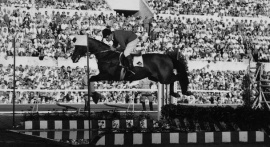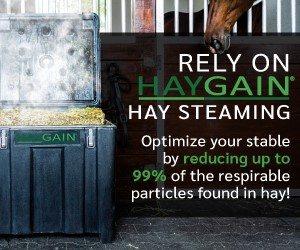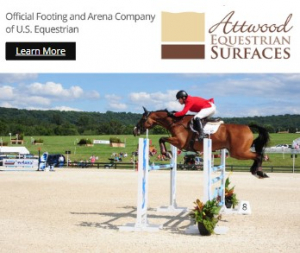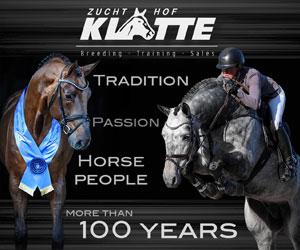You are here
Home › Articles › Hall of Fame › Halla another Showjumping Star from the past Olympic / World Championships ›Halla another Showjumping Star from the past Olympic / World Championships
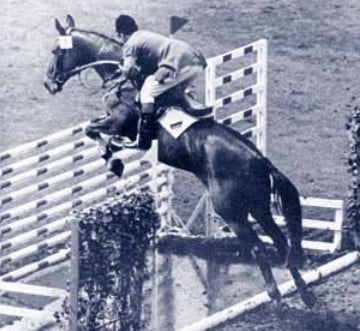
Stockholm 1956: “Halla” at the sixth barrier – a water jump with stationary objects: height 1.50 m, width 2.15 m
Halla, a bay mare with the distinctive white spot on her forehead ridden by Hans Günter Winkler, is the only horse ever to win three Olympic Gold medals in the sport of show jumping.
Halla (also known as “Sonnenglanz”) was born in the yard of Gustav Vierling in Darmstadt out of Helene, a French trotter horse of unknown breeding, and the Standardbred Oberst. Initially trained for steeplechase, Halla was discovered by the German Olympic Committee for Eventing. The mare was considered very difficult and changed riders several times.
Despite great talent, she was unsuccessful.
Halla is of humble origins. Of her mother “Helene” it is only known that she was a “booty horse”, ridden in the war by a German officer. Why he allowed her to remain in the stable of Darmstadt farmer Gustav Vierling is unknown. Vierling gave the horse to his son. At country tournaments the son demonstrated that the lady, although getting on in years, could still jump respectably.
As Vierling thought it a shame to harness her to the plough, he wished for a foal from her, a duty entrusted to the trotting stallion “Oberst”. After eleven months, on 16th May 1945, a ‘peace baby’ came into the world, entered in the Hessen studbook under the name “Halla”.The temperamental little horse began her career on the trotting track at Frankfurt-Niederrad, where she performed creditably. But it soon became clear that the mare, despite her speed, could not keep up with thoroughbreds.
Halla
Halla Pedigree Chart by SporthorseData
Halla Pedigree Chart by SporthorseData
| Oberst DT-DE-32-BAY |
Palmetto Watts TRU-USA-13 |
General Watts SB-USA-04-BAY |
Axworthy | Axtell | US-5183 |
| Marguerite | |||||
| Carpet | Prodigal | ||||
| Annie Wilton | |||||
| Ottaray Belle TRU-USA-07 |
Rhythmic | Oakland Baron | |||
| Duchess | |||||
| Night Queen | Alcatraz | ||||
| Luni | |||||
| Odelis TRU-USA-22 |
Morgenwind TRU-USA-11-CH |
Morgan Axworthy | Axworthy | ||
| Kinglyne | |||||
| Della Bell | Adbell | ||||
| Del Worthy | |||||
| Ottaray Belle TRU-USA-07 |
Rhythmic | Oakland Baron | |||
| Duchess | |||||
| Night Queen | Alcatraz | ||||
| Luni | |||||
| Helene FDS-FR-29-BAY |
Ulon FDS-FR-20-BAY |
Milon FDS-FR-12-CH |
Bordeaux | Dacapo | |
| Finette | |||||
| Coquette | Cafe | ||||
| Coquette | |||||
| Quotidienne FDS-FR-16 |
Karikal | Cerbere | |||
| Querelle | |||||
| Cambuse | Osiris | ||||
| unknown | |||||
| Anglo Norman Mare FDS-FR-2x |
unknown |
unknown | unknown | ||
| unknown | |||||
| unknown | unknown | ||||
| unknown | |||||
| unknown |
unknown | unknown | |||
| unknown | |||||
| unknown | unknown | ||||
| unknownMode A |
At the Helsinki Olympics of 1952, the Germans were re-admitted to the Olympic fold. As the Games approached, a call for fresh equine material rang out, Vierling offered the Olympic Committee the chance to take over “Halla”
Meantime Dr. Rau, the Oberland head groom, had asked Winkler if he would like to come to Warendorf, with the prospect of a job. Thereupon Winkler made a quick decision to transport his three tournament horses and his small amount of luggage to Warendorf. When he arrived, he discovered he was not welcome. The job had been given to a former officer. Before he travelled back to Frankfurt in disappointment, he was generously permitted to accommodate his horses in the former German Army stables, where there was not a single piece of wood left. Friends helped him out of the fix.
On his first meeting with “Halla” he had got along with her, the only one to do so. Three months later, on 13th July 1950, Winkler received a telegram, in which Dr. Rau asked if he could ride “Halla” at a three-day-event. Winkler was willing, but afterwards he had to return the horse back to the Military rider Otto Rothe, who had been selected for Helsinki.
But Winkler remained on the list. In 1951 he was called to a four week long Olympic course where which he received instruction for the first and only time. His trainer was Marten von Barnekow who had been the instructor at the main SS riding school in Munich-Riem.
Halla’s career seemed to be ended prematurely on 16th October 1951 when she was ridden by an unfamiliar rider with the intention of competing in the Military competition. But the result was devastating. In dressage she showed herself to be a total disaster. In jumping she lacked feeling for the obstacles and then she bolted with her rider. It was a bitter blow for farmer Vierling when Dr. Rau telephoned to ask him to collect his animal, because nothing sensible could be done with her.
Some time later Vierling came to Warendorf to take part in a breeders’ conference. He met Winkler in the street, where he spoke a few words, but they were to prove decisive ones for man and animal:
“Herr Winkler, you were the only one who came to terms with the horse. Do you want the mare?”
Winkler was rather short of money that is certain, but he remained determined to finally own a horse that he would not have to give back on the next occasion to someone else. The deal was sealed with a handshake. Winkler worked with “Halla” for a year and a half. By this time she understood what he wanted from her. He watched her for hours and came to the verdict that she was a mixture of “crazy goat” and “genius”. Der Spiegel concluded: “She is a real child of the post-war period”.
Winkler remains convinced that “Halla” was very intelligent. As a foal, she was often alone on the farm. A wire fence 1.30 metres high separated the land from a railway embankment. Twice a day, the express thundered by. “Halla” was unmoved. The train raced, she grazed.
In Warendorf there arose then a sporting partnership, in which “Halla” was the diva, who knew what she could do. Like an actress she wanted to be left in peace an hour before performing. Then she approached her task professionally. And yet, like a real star, she remained unpredictable. If previously she was calm and concentrated, she could also freak out, for instance when the victory wreath was to be hung round her neck.
Winkler accepted this character and developed his own style. It was barely visible to any one watching but when he rode her, he used only his thighs and his knees and spread his bodyweight forwards, which became known as the “Winkler style”. Otherwise “Halla” knew neither whip nor spurs nor loud commands. On the course, looking at the last obstacle, the rider spoke to her: “Watch out!”, “Make an effort!”, “Don’t let me down!”. They merged like a mythical centaur.
In 1951, an up and coming show jumping star, Winkler, took on the difficult ride and the rest is history. They won back-to-back World Championships in show jumping when she and Winkler competed at the 1956 Olympics in Stockholm.
In the first round, Winkler pulled a groin muscle at the penultimate obstacle, after his mare took off early and threw him out of position. Despite the pain, Winkler decided to ride in the third round, as the German team would be eliminated without him. After he was given tranquilizers, Winkler found that he was comfortable sitting, but riding was difficult and painful. Any drugs that could reduce the pain enough to make him comfortable in the saddle would also reduce his mental capacity, and therefore he was only given black coffee before his ride to try to help reduce his dizziness and double-vision.
In this state, Winkler was only able to bring Halla up to the obstacles, but could no longer transmit the usual signals to her by means of leg pressure. Winkler, who could hardly stay in the saddle, screamed in pain over the obstacles - and was the only rider to jump clear.
At the last obstacle, the reporter Hans-Heinrich Isenbart enthusiastically shouted the legendary sentence: "And Halla laughs as if she knew what it was all about." With this, the German show jumpers had won gold in the team competition, and Winkler was Olympic champion in the individual competition despite Winkler suffering through tremendous amounts of pain
Four years later, at the 1960 Olympics in Rome, Halla and Winkler led the German team to another victory.
Halla stands as the horse with the most gold medals from the Olympic Games in The Guinness Book of the Records, which is merely the icing on the cake of her 125 recorded jumping competition wins.
Main Successes:
Olympic games
1956 in Stockholm : Gold medal team
1956 in Stockholm : gold medal singles
1960 in Rome : gold medal team
World Championship
1954 in Madrid : gold medal singles
European Championship
1958 in Aachen : individual bronze medal
German championships
1959 in Berlin : German champion
Halla retired from the sport on October 25, 1960 to begin her career as a broodmare.
She had eight foals but they were not as successful as her. Halla died on May 19, 1979, at 34 years old on the farm where she was born.
Up until her death Halla received countless thank-you letters and packets of sugar cubes. Even today, the exceptional horse receives fan mail.
In Warendorf , the seat of the German Equestrian Association (FN), a street was named after her.
The life-size bronze sculpture created by the Berlin animal sculptor Hans Joachim Ihle was erected in her honour in front of the headquarters of the German Olympic Equestrian Committee in Warendorf is still a tourist attraction. The model, whose height is given as 1.71 metres (17.5 hands), survived the inauguration.The statue in bronze depicts the wonder mare in elegant pose, head erect and ears attentively pricked as was her wont when she approached a fence with Winkler. The Hessian mare conveys the impression of sovereign elegance, on the other hand she stands pleasantly unpretentiously and modestly. This is well known as the sign of true greatness.
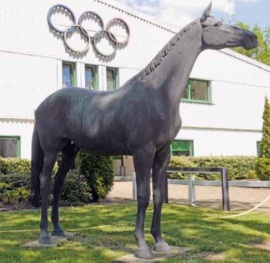
The Equestrian Federation has decreed that no competition horse may ever again compete under the name Halla. The "miracle mare" is to remain unique forever.
The artist Gunther Granget was commissioned to model a porcelain figure of the mare.
Reference: The Centaur from Warendorf by By Volker Kluge
Copyright sporthorse-data.com 2005-2025. All rights reserved data is protected by database right.
Comments

Great research, excellent article. When I was researching her for my Standardbred book, I thought it odd that her damsire was unknown, only listed as a TB named Ulan. TBs are registered and I knew there should be a record of him. There was no TB named Ulan anywhere near the time in France that could have sired her dam. Then I realized it could be a typo...that someone wrote down Vlan as Ulan...easy to do...and viola, there was indeed a TB used in French Trotter breeding at the right time and place:Vlan. I posted this in my chapter on Halla.
Don't you think it odd that the jumper breeders don't really look at Trotters as a source? The Selle Francais of course relied on trotter blood, to build their breed....you would think that would be a clue for people....or maybe that the Holstein that arise from the Yorkshire, a trotter coach horse would give them a clue. But oh no, trotters are not allowed crosses in their product. It's comical.
I am glad you enjoyed the article Kathleen. I have updated her pedigree to include Vlan. Yes I agree the Trotters are under-rated for breeding showjumpers. Remember the great Galoubet's dam Viti was a French Trotter. We should look at the Trotter more.
